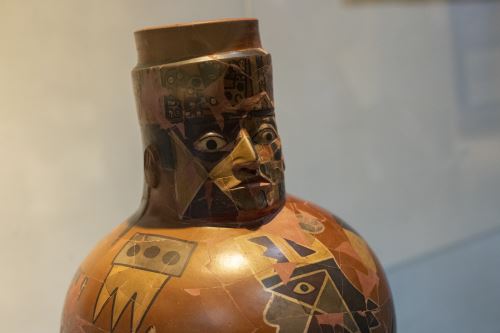15:00 | Ayacucho (Ayacucho region), May. 18.
New findings on the pre-Columbian city of
Wari, in Ayacucho region, are being exhibited. They were made by a team of archaeologists from the National University of San Cristobal de Huamanga over the past 10 years.
At the laboratory of the
National University of San Cristobal de Huamanga (UNSCH), archaeologists have put together the pieces of vessels that were ritually destroyed in the city of Wari to shed light on a culture that was a warlike society and, at the same time, was economically based on large-scale craftsmanship.
The Wari (600 to 1,000 AD) were the grandparents of the Incas and, if Ayacucho is the capital of Peruvian handicrafts nowadays, it is not free: working with clay is in the genes of its potters.
The temporary exhibition "Wari: New findings and evidence of the first Andean Empire" has been staged in two rooms at the Cultural Center of the UNSCH, in Ayacucho's Main Square or Plaza Sucre.
The exhibit was the result of about a decade of work, which began in 2011, by a team led by Ayacucho archaeologists Jose Ochatoma and Martha Cabrera. The team completed its excavation activities in 2019. Afterwards, they started to analyze the archaeological material at the laboratory.
Wari is a great mystery. It is estimated that the pre-Columbian citadel housed up to 50,000 inhabitants at its peak and covered an area of 600 hectares, of which not even 50 hectares are visible. Most of them are covered in vegetation or located underground.
Revealing ceramics
One of the findings that stands out at the exhibition is a very brightly colored ceramic that represents a trachea, lungs, and a heart. It is a unique piece that suggests new interpretations about this civilization, since only abstract representations had been observed in the past.
"This piece has provided a link to be unraveled. It suggests that they made human sacrifices to their mythological deities," Jose Ochatoma explained. Considering the high quality and detail shown in said piece, the Wari must have dissected corpses and made sacrifices.
Researchers of this civilization have found plumb lines and other instruments that they used to build their cities.
If there were divergent views on whether or not the Wari were an empire, one of the vessels tipped the scales in favor of the imperial theory, suggesting the existence of a large army that conquered territories. Said ceramic shows a character being carried by a Wari warrior. He has feathers on his back and a rope around his neck.
"We believe that the man who is being carried was one of the Huarmey leaders conquered by the Wari; he was captured and carried to the Wari capital with a rope around his neck. The individual was found in 2013, in Huarmey (located north of Lima), by a group of Peruvian and Polish archaeologists led by Dr. Milosz Giersz," Ochatoma said.

A similar scene has been identified on a third vessel. It depicts the Lord of Vilcabamba, who is wearing silver plates and is carried by another Wari warrior with a rope around his neck. Both are complemented by a vessel at the Wari onsite museum, where there is a representation of heads with their tongues sticking out, each one with a different type of cap.
According to Jose Ochatoma and Martha Cabrera, when the Wari began their expansion process, they captured these lords, brought them to the city, and cut their neck.
The new data that have become available thanks to recent findings confirm that this culture, which originated in Ayacucho, had an army organized in specialized commands, each one including different representations.
From lime to pozzolan
Another issue that researchers have verified along with the restorer is that the Wari used pozzolan as raw material for their constructions, taking advantage of the fact that there were several stone quarries in the surroundings.
Moreover, the water shortage was solved by diverting water from a lake through a 16 km long system of channels to distribute it throughout the city. This facilitated the development of craft activities.
Agricultural feline
Another peculiarity is that the head of the feline, a deity that was already represented by the Tiahuanaco culture, in an abstract way, featuring a crown, legs, and claws, undergoes a great change in Ayacucho: the fierce God of Tiahuanaco becomes a deity of corn production, according to researchers.
If the first gods of Tiahunaco depict sunrays as snakes and the jaguar as symbols of fire and rain; in the case of Wari, the deity depicts corn. They also use representations of chicha de molle and corn, as well as huilca, which is a hallucinogenic product.
A decade of excavations led by Ochatoma and Cabrera in Wari have made it possible to find one of the few fabrics, because the acidity of the soil in the area does not allow these garments to be preserved.
Elite women
Another important issue on which they shed light is the presence of women: until now, there was no evidence of the role that they fulfilled in the Wari civilization. However, now it is becoming clear that the best potters were women, thanks to a representation of an elite female holding a pen, a paintbrush, and a cup, which has been found.
"They are elite women because of the type of clothing they wear: tupu and cape. It was not a common clothing for Wari women," they explained.
(END) DOP/JVV/RMB/MVB
Published: 5/18/2022